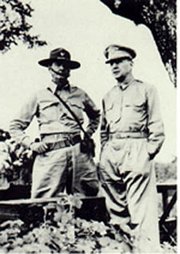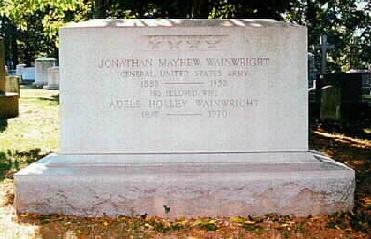Jonathan Mayhew Wainwright IV
|
|
- This page is about General Wainwright. For others named Jonathan Wainwright, see Jonathan Wainwright (disambiguation).
Jonathan Mayhew Wainwright IV (August 23, 1883 – September 2, 1953), was a United States Army general and the commanding officer of Allied forces in The Philippines, at the time of their surrender to the Empire of Japan during World War II.
| Missing image Genwainwright2.jpg Jonathan Wainwright |
| Contents |
Early Life and Training
Wainwright was born at Fort Walla Walla, Washington and was the son of Robert Powell Page Wainwright, a US Army officer who commanded a squadron at the Battle of Santiago during the Spanish-American War. He graduated from West Point, in 1906, and was commissioned in the cavalry. He served with the 1st Cavalry Brigade in Texas from 1906–08 and in the Philippines from 1908–10, where he saw combat on Jolo, during the Moro Rebellion. Wainwright graduated from the Mounted Service School, Fort Riley, Kansas, in 1916 and was promoted to Captain. By 1917 he was on the staff of the first officer training camp at Plattsburg, New York.
World War One
In February 1918, he was ordered to France, during World War I. In June, he became Assistant Chief-of-Staff of the 82nd Infantry Division, with which he took part in the Saint Mihiel and Meuse-Argonne Offensives. As a temporary Lieutenant Colonel, he was assigned to occupation duty in Germany with the 3rd Army at Koblenz, Germany, from October 1918 until 1920. Having reverted to the rank of Captain, he was then promoted to Major.
Inter-War Period
After a year as an instructor at the Cavalry School at Fort Riley, he was attached to the General Staff from 1921–23 and assigned to the 3rd Cavalry Brigade, Fort Myer, Virginia, from 1923–25. In 1929, he was promoted to Lieutenant Colonel and graduated from the Command and General Staff School, Fort Leavenworth, Kansas, in 1931, and from the Army War College in 1934. Wainwright was promoted to Colonel in 1935, and served as commander of the 3rd Cavalry until 1938, when he was promoted to Brigadier General in command of the 1st Cavalry Brigade at Fort Clark, Texas.
World War II

In September 1940, Wainwright was promoted to Major General (temporary) and returned to the Philippines, in December, as commander of the Philippine Department. As the senior field commander of Filipino and US forces—under General Douglas MacArthur—Wainwright was responsible for resisting the Japanese invasion of the Philippines, which began in December 1941. Retreating from the Japanese beachhead of Lingayen Gulf, Allied forces had withdrawn onto the Bataan Peninsula and Corregidor by January 1942, where they defended the entrance to Manila Bay.
Following the relocation of MacArthur to Australia in March, to serve as Allied Supreme Commander, South West Pacific Area, Wainwright inherited the unenviable position of Allied commander in the Philippines. On April 9, the 70,000 troops on Bataan surrendered. In March, Wainwright was promoted to Lieutenant General (temporary). On May 5, the Japanese attacked Corregidor and on May 6, in the interest of minimising casualties, Wainwright surrendered. By June 9, Allied forces had completely surrendered.
Wainwright was then held in prison camps in northern Luzon, Formosa, and Manchuria until his liberation by Russian troops in August 1945. After witnessing the Japanese surrender aboard the USS Missouri (BB-63) on September 2, he returned to the Philippines to receive the surrender of the local Japanese commander.
He was later awarded the Medal of Honor. Wainwright won the respect of all who were imprisoned with him. His men often dubbed him a "fighting" general who was willing to get down in the foxholes. Wainwright agonized over his decision to surrender Bataan all during his captivity. He felt he had let his country down. Upon release, the first question he asked was "How am I thought of back in the states?" He was amazed when told he was considered a hero. During Wainwright's imprisonment, General MacArthur angrily wrote a memorandum saying Wainwright should be denied the Medal of Honor. He forwarded this to Army Chief of Staff George C. Marshall. He derided Wainwright's leadership abilities and implied he was both a coward and an alcoholic. Many had criticized this memorandum as slanderous and cruel. Ironically, MacArthur was widely scorned for leaving the Philippines and many felt his Medal of Honor was a publicity stunt because, unlike General Wainwright, he was never anywhere near the front lines. Even after General Wainwright learned of MacArthur's comments, he still remained friends with the man and even supported him in his Presidential bid in 1952.
His Medal of Honor citation reads:
- Distinguished himself by intrepid and determined leadership against greatly superior enemy forces. At the repeated risk of life above and beyond the call of duty in his position, he frequented the firing line of his troops where his presence provided the example and incentive that helped make the gallant efforts of these men possible. The final stand on beleaguered Corregidor, for which he was in an important measure personally responsible, commanded the admiration of the Nation's allies. It reflected the high morale of American arms in the face of overwhelming odds. His courage and resolution were a vitally needed inspiration to the then sorely pressed freedom-loving peoples of the world.
Post-War Years
In 1945, shortly after the Japanese surrender, he received his 4th star. In January 1946, Wainwright became the commander of the 4th Army, Fort Sam Houston, Texas. He retired in August 1947.
Death
General Wainwright is buried in Section 1 of Arlington National Cemetery and is one of the few people to have had their funeral held in the lower level of the Memorial Amphitheater.


